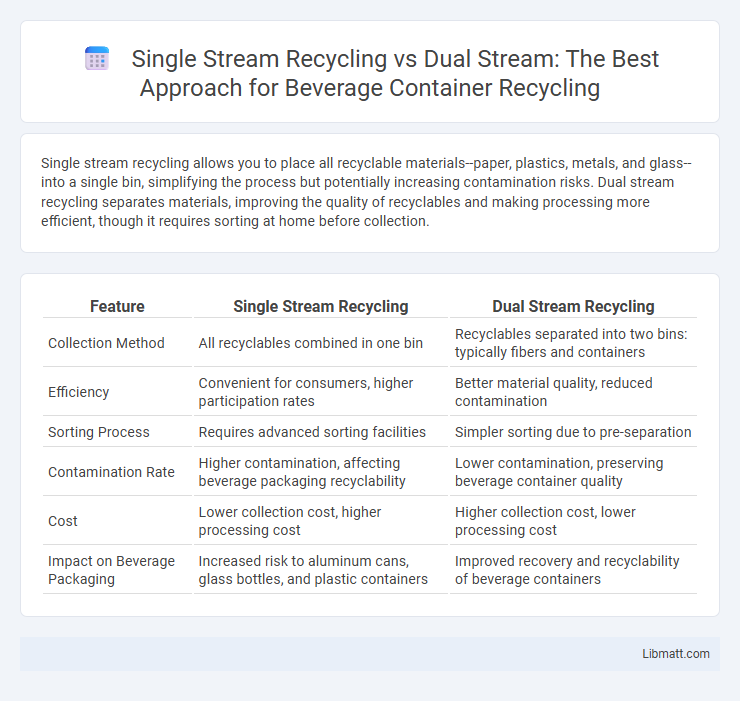Single stream recycling allows you to place all recyclable materials--paper, plastics, metals, and glass--into a single bin, simplifying the process but potentially increasing contamination risks. Dual stream recycling separates materials, improving the quality of recyclables and making processing more efficient, though it requires sorting at home before collection.
Table of Comparison
| Feature | Single Stream Recycling | Dual Stream Recycling |
|---|---|---|
| Collection Method | All recyclables combined in one bin | Recyclables separated into two bins: typically fibers and containers |
| Efficiency | Convenient for consumers, higher participation rates | Better material quality, reduced contamination |
| Sorting Process | Requires advanced sorting facilities | Simpler sorting due to pre-separation |
| Contamination Rate | Higher contamination, affecting beverage packaging recyclability | Lower contamination, preserving beverage container quality |
| Cost | Lower collection cost, higher processing cost | Higher collection cost, lower processing cost |
| Impact on Beverage Packaging | Increased risk to aluminum cans, glass bottles, and plastic containers | Improved recovery and recyclability of beverage containers |
Introduction to Single Stream and Dual Stream Recycling
Single stream recycling allows you to place all recyclable materials--like paper, plastic, and metal--into one bin, simplifying the sorting process for households and businesses. Dual stream recycling separates materials into two categories, usually fibers (paper and cardboard) and containers (glass, metal, plastic), which can improve the quality of recyclables by reducing contamination. Choosing between single stream and dual stream recycling depends on your local recycling program's capabilities and your commitment to maximizing material recovery.
How Single Stream Recycling Works
Single stream recycling collects all recyclable materials--paper, plastic, glass, and metal--in a single bin, simplifying the sorting process for consumers. Material Recovery Facilities (MRFs) use advanced machinery such as screens, magnets, and optical sorters to separate materials efficiently after collection. This method increases participation rates by making recycling more convenient but may lead to higher contamination levels compared to dual stream systems.
How Dual Stream Recycling Works
Dual stream recycling separates recyclables into two distinct categories: paper products and containers such as glass, metal, and plastic. This system reduces contamination by keeping materials apart, improving the quality and value of the recycled output. Recycling facilities use specialized equipment to process and sort each stream efficiently, enabling higher recovery rates and better marketability for recycled materials.
Key Differences Between Single Stream and Dual Stream Recycling
Single stream recycling collects all recyclables--paper, plastics, metals, and glass--together in one bin, simplifying disposal but increasing contamination risk. Dual stream recycling separates fibers (paper and cardboard) from containers (plastics, metals, and glass), improving material quality and market value but requiring more sorting effort. Key differences include collection convenience, contamination rates, processing costs, and end-product purity, influencing municipal recycling program choices.
Contamination Rates in Single vs. Dual Stream Recycling
Single stream recycling often experiences higher contamination rates due to mixed materials being collected together, which can compromise the quality of recyclables. Dual stream recycling separates paper from containers, reducing contamination and improving the efficiency of sorting facilities. You benefit from cleaner recyclable materials, which increases the likelihood of successful recycling and reduces processing costs.
Cost Analysis: Single Stream vs. Dual Stream Systems
Single stream recycling systems generally incur lower collection costs due to simplified sorting processes and reduced labor expenses at the curbside, while dual stream systems demand higher initial investments in separate bins and increased sorting labor but achieve higher purity levels in recyclables. Studies indicate that single stream expedites curbside collection and reduces vehicle fuel consumption, yet dual stream often results in less contamination, decreasing processing costs downstream at materials recovery facilities (MRFs). Cost-effectiveness depends on factors such as local market conditions, contamination rates, and MRF technology, with single stream favored in urban areas and dual stream preferred where maximizing material quality is priority.
Environmental Impact of Single and Dual Stream Recycling
Single stream recycling simplifies collection by combining all recyclables, but it often results in higher contamination rates, reducing the quality of recycled materials and increasing landfill waste. Dual stream recycling separates paper from containers at the source, leading to cleaner recyclables, higher recovery rates, and lower environmental impact due to improved sorting and processing efficiency. Your choice between these systems can influence carbon emissions, resource conservation, and the overall effectiveness of recycling programs.
Efficiency and Convenience for Users
Single stream recycling offers greater convenience for users by allowing all recyclables to be placed in one bin, reducing sorting effort and encouraging higher participation rates. Dual stream recycling improves efficiency in processing by separating paper from containers at the source, resulting in cleaner materials and higher quality recyclables. Your choice depends on balancing user convenience with the potential for increased material recovery and processing quality.
Processing Challenges and Solutions
Single stream recycling faces processing challenges such as higher contamination rates and difficulty in sorting mixed materials, leading to increased operational costs and lower-quality recyclables. Dual stream recycling separates fibers from containers at the source, reducing contamination and improving sorting efficiency, but requires more complex collection logistics. Advanced technologies like optical sorters and robotic arms enhance material recovery in single stream systems, while dual stream benefits from streamlined processing due to cleaner input streams.
Choosing the Best System for Your Community
Single stream recycling simplifies sorting by allowing all recyclables to be placed in one bin, improving participation rates but increasing contamination risk. Dual stream recycling separates materials into categories like paper and containers, resulting in higher-quality recyclables and reduced processing costs for facilities. When choosing the best system for your community, consider factors such as local recycling infrastructure, contamination tolerance, and public convenience to maximize environmental and economic benefits.
Single stream recycling vs dual stream Infographic

 libmatt.com
libmatt.com